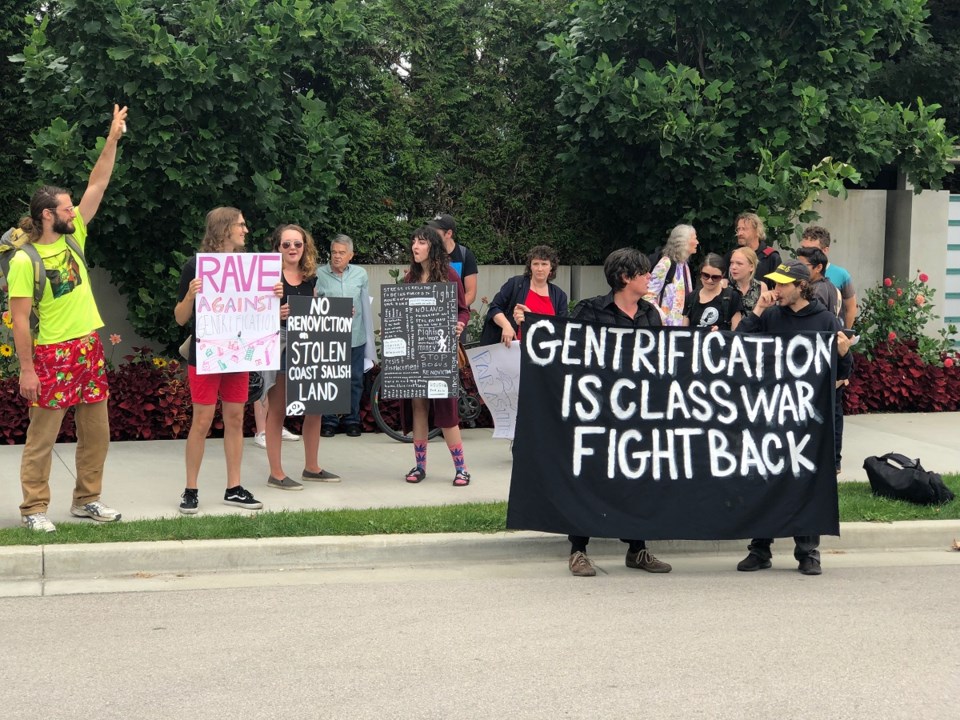If the young artists recently encamped outside the $73-million Point Grey compound of Chip Wilson were expecting to be consoled for the massive rent hikes they were facing for buildings his company recently purchased, the multi-billionaire had this to say to them:
“The world doesn’t want enough of your product for you to pay the rent.”
Somewhere Marie Antoinette had a good smirk after hearing that.
Wilson once paid music artists Red Hot Chili Peppers $1 million for a single-evening exclusive performance at his house that was attended by Mayor Gregor Robertson among others. On Aug. 10, he chose to directly address the 60 or so artists outside his home to protest rent increases.
He started by saying, “when I was young,” then tried to relate to the crowd by saying he had gone to the school of hard knocks himself. As one friend remarked, it was classic Chip.
The reason for the rally was that several commercial buildings used by local artists for creative space had new rents set by Wilson’s company Low Tide Properties. In 2016, the company a plan to acquire up to $1.5 billion in property assets.
“Low Tide’s strategy is to acquire and hold a core of stable, income-producing properties (mostly office/retail/industrial/multi-family properties in the Lower Mainland) while also acquiring value-add properties to improve and then add to the core. Examples include a number of properties in the Gastown and Broadway/Mount Pleasant areas.”
Some of the neighbourhoods flagged by the company are in transition, which makes them ideal locations for artists’ studios because of the lower cost to rent them out. But Low Tide has made no concessions to the current inhabitants, and has moved ahead by requiring market rents.
While some of us might shrug this off as an example of our society’s capitalist underpinnings, one could also argue that a city where a lack of affordability displaces its community of artists is not where many of us would want to live.
Artists are the first to experience gentrification which, ironically, they play a part in. It is their hipster venues that make communities safer and more appealing, allowing for a gradual increase in real estate development.
The artists maintain that by occupying some of the buildings companies like Low Tide now own, they help to maintain a vibrancy on the street. It is shown that buildings left empty due to overpriced rents will deaden neighbourhoods and allow property crime to flourish.
Back in 2007, I was able to convince then Mayor Sam Sullivan to meet with a small business operator who wanted to revamp a commercial property in the heart of the Downtown Eastside. The complaint then and now is that city inspectors require costly renovations to bring spaces “up to code.”
A few months later, after working with staff, Sullivan held a news conference on the property, which still operates 12 years later as a space for emerging artists. It still does not meet current building codes, but all considerations have been met for life safety.
The problem with these spaces is two-fold. The first happens when owners set a target of maximum profitability, and would sooner leave the space empty than let it out at a fairer rent.
Thankfully, there are multiple property owners who take a progressive approach over the short term, and require little more than covering the cost of their property taxes.
The second is that the city has no tools for providing temporary use on a building — such as a five-year zoning change that would permit artists to use the property until the building is demolished or significantly redeveloped.
A change like this is something that would ultimately involve provincial legislation. It would also be a win for artists, the city and building owners alike.
Artists will often occupy buildings whether they meet the city’s strict standards or not. In order to prevent a disaster, inspectors should be able to ensure there are appropriate emergency exits or the right number of fire extinguishers, without cracking down on a costly checklist of improvements.
The public should demand changes that encourage more creative space and not be asking whether the world wants to pay top dollar for someone’s art.
@MikeKlassen



